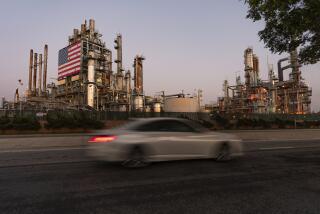Back on the Right Route
- Share via
Fifteen years ago, under the spur of the Arab oil embargo and the blocks-long lines at gasoline pumps it led to, Congress decreed an end to the era of uncontrolled energy consumption. It told the Transportation Department to set standards requiring auto makers to steadily improve the average fuel efficiency of their fleets or face heavy fines. Detroit moaned and groaned, wept and wailed, but one way or another it pretty much achieved what Congress wanted. In 1974 the average American car could go only 14 miles on a gallon of gasoline. By the 1985 model year that average had reached 27.5 m.p.g.
Then the Reagan Administration, in a move suggesting it had never heard of oil embargoes, trade deficits, air pollution, the greenhouse effect or any of the other compelling reasons for curtailing oil consumption, heeded the call of the U.S. auto companies and rolled back the fuel standards, to 26 m.p.g for the 1986-87-88 model years and 26.5 m.p.g. for 1989. That regression, said Detroit, was forced by the demands of the buying public, whose appetite for less-fuel efficient--and, happily for the auto makers, more profitable--bigger cars, light trucks and four-wheel drive vehicles had grown anew as oil prices had come down. Gasoline, in other words, had become too cheap and was no longer a disincentive to buying gas-guzzlers.
Not content with just lowering the fuel efficiency standard, the Reagan Administration actually wanted to abolish it, arguing that the marketplace alone should determine what cars would be made and sold. In short, it was ready to go back to the good old days that preceded the oil supply panic of 1973. The Bush Administration has shown no interest in endorsing such lunacy. Instead, recognizing that smog, the damage done to the atmosphere from burning fossil fuels and the $40 billion a year that oil imports add to the trade deficit are all serious problems and legitimate matters of public policy, it has indicated it will restore in 1990 the 27.5 m.p.g. standard that existed in 1985.
That’s fine, and even though the action would come too late to let auto companies make changes in their 1990 models, the tougher standard shouldn’t present too great a problem. Both GM and Chrysler, for example, exceeded the 27.5 m.p.g. standard for the 1988 model year; Ford’s 1988 fuel efficiency fell a bit short, but credits banked when it exceeded the standards in previous years should let it meet the goal. But a return to the 1985 standards, while achievable and certainly desirable, is not the end-point for better fuel efficiency.
A number of studies, among them one by Congress’ Office of Technology Assessment, have found that technologies already in use on some cars make 33-35 m.p.g. averages by the mid-1990s a clearly feasible prospect. To get there may require somewhat reducing the size and so the weight of some of today’s biggest cars. That isn’t too onerous a price to pay. As some of the Japanese car makers have shown, comfortable, safe and fast-accelerating cars that are also highly fuel efficient are not a problem to build. Those are the same manufacturers, of course, whose imports Detroit has succeeded in curbing throughout most of this decade.
A recent federal-private study concluded that U.S. oil consumption today is 2 million barrels a day below what it would be if automobile fuel efficiency hadn’t improved since 1975. That represents tens of billions of dollars in savings to consumers over the last 14 years. Even greater savings in the 1990s are achievable. More to the point, they are clearly necessary, both to provide some relief to a beset environment and to reduce the chances--already worryingly high--that the country could again invite severe economic woe by becoming overdependent on unreliable foreign oil suppliers. Going back to the 27.5 m.p.g. standard is a beginning, but only that. The next step is for Congress to seize the initiative by setting higher fuel-efficiency goals for the decade ahead, making it possible for the United States to cut its projected oil consumption by more hundreds of thousands of barrels a day. Technically, that can be done. What’s needed now is the vision and will to do it.






